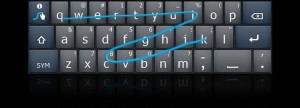Embedded systems are, for the most part, invisible to the end user, yet the end application would not work properly without them. So what form does innovation take for something that is only indirectly visible to the end user? Swype’s touch screen-based text input method is such an example. The text entry method already exists on the Samsung Omnia II and releases on July 15 for the Motorola Droid X.
Swyping is a text entry method for use with touch screens where the user places their finger on the first letter of the word they wish to type. Without lifting their finger, the user traces their finger through each of the letters of the word, and they do not lift their finger from the touch screen until they reach the final letter of the word. For example, the figure shows the trace for the word quick. This type of text entry requires the embedded engine to understand a wider range of subtle motions of the user’s finger and couples that with a deeper understanding of words and language. The embedded engine needs to be able to infer and make educated guesses about the user’s intended word.
 Inferring or predicting what word a user wishes to enter into the system is not new. The iPhone, as well as the IBM Simon (from 1993), use algorithms to predict and compensate for finger tap accuracy for which letter the user is likely to press next. However, swyping takes the predictive algorithm a step further and widens the text entry system’s ability to accommodate even more imprecision from the user’s finger position because each swyping motion, start to finish, is associated with a single word.
Inferring or predicting what word a user wishes to enter into the system is not new. The iPhone, as well as the IBM Simon (from 1993), use algorithms to predict and compensate for finger tap accuracy for which letter the user is likely to press next. However, swyping takes the predictive algorithm a step further and widens the text entry system’s ability to accommodate even more imprecision from the user’s finger position because each swyping motion, start to finish, is associated with a single word.
In essence, the embedded system is taking advantage of available processing cycles to extract more information from the input device, the touch screen in this case, and correlating it with a larger and more complex database of knowledge, a dictionary and knowledge of grammar in this case. This is analogous to innovations for other embedded control systems. For example, motor controllers are able to deliver better energy efficiency because they are able to collect more information about the system and environment they are monitoring and controlling. Motor controllers are measuring more inputs, inferred and directly, that allows them to understand not just the instantaneous condition of the motor, but also the environmental and operational trends, so that the controller can adjust the motor’s behavior more effectively and extract greater efficiency than earlier controllers could accomplish. They are able to correlate the additional environmental information with an increasing database of knowledge of how the system operates under different conditions and how to adjust for variations.
The Swype engine, as well as other engines like it, supports one more capability that is important; it can learn the user’s preferences and unique usage patterns and adjust to accommodate those. As embedded systems embody more intelligence, they move away from being systems that must know everything at design time and move closer to being systems that can learn and adjust for the unique idiosyncrasies of their operating environment.
[Editor's Note: This was originally posted on Low-Power Design]
Tags: Touch Screens

[...] pen-up/down model by supporting hover or mouse-over emulation. The new typing method supported by Swype pushes the pen-up/down model yet another step further by combining multiple touch points within a [...]
This is such a great resource that you are providing and you give it away for free. I enjoy seeing websites that understand the value of providing a prime resource for free. I truly loved reading your post. Thanks!